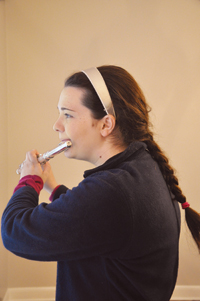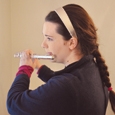One of our goals as teachers is to help student flutists create a lovely, musical performance in a recital or ensemble performance. Yet, so many times the performance is marred by noisy breathing. This is distracting for the audience and makes listeners concentrate on the effort it takes to play the flute rather than on the beautiful sound and musical phrasing the player is trying to convey.
Noisy breathing is a common occurrence of flutists. Some do it all the time. Other flutists breathe quietly in practice and in lessons, yet become noisy when nervous during a performance or audition. Understanding what causes the problem can help flutists learn to breathe quietly.
Noisy breathing occurs when there is a blockage somewhere in the breathing passages. This blockage, which can be anyplace between the aperture in the lips to the lungs, may be caused by medical issues such as an infection, anatomical defect (deviated nasal septum), asthma, or some other condition. If a flutist has none of these problems and only exhibits noisy breathing when playing, more than likely the it is caused by poor posture or improper placement of the tongue in the mouth.
A Good Position
When playing the flute with a good position, there will be no blockage of the air column so breathing is quiet. When playing the flute, driving a car, or working on a computer, the head should balance on the spine. Slowly nod your head up and down to explore and discover this balanced position. Many flutists describe the place of balance as being at the bottom of a very small nod as if nodding okay in agreement with someone.
If the head is held too high, as if looking at the top row of a balcony, the weight of the head is placed too far back on the spine and it is not balanced on the spine. This position often develops after a flutist has participated in a lengthy marching band season. Teachers should regularly review the differences between performing on a football field and in a concert hall.
Likewise if the head is placed too far forward or down, as in a large nod, the head again is not balanced on the spine. Flutists often develop this position when practicing with a music stand adjusted too low or practicing with music propped up with a pillow on a bed.
Explore these two incorrect positions with students to demonstrate that the correct placement of the head is someplace in between the forward and back positions.
 Doing the Turtle
Doing the Turtle
When a flutist juts the jaw forward (like a turtle coming out of his shell -see picture on right) to make contact with the flute, the spine in the neck comes forward and presses against the vocal folds. Then when the flutist takes a breath, the vocal folds are hampered, and the breathing is noisy.
 To correct this bad habit of moving the jaw to the flute rather than the flute coming to the flutist, have students recline on the floor. You may wish to put several small paperback books under the head for comfort. Then with the headjoint only, have students bring the headjoint into the chin and play a few notes. Once they realize where the head must be, the turtle movement is corrected (picture on left).
To correct this bad habit of moving the jaw to the flute rather than the flute coming to the flutist, have students recline on the floor. You may wish to put several small paperback books under the head for comfort. Then with the headjoint only, have students bring the headjoint into the chin and play a few notes. Once they realize where the head must be, the turtle movement is corrected (picture on left).
Tongue Placement
When playing, the tip of the tongue may touch in the aperture, top lip, bottom of the teeth, or the roof of the mouth. However, if left in this position when taking a breath, the breathing is noisy. Flutists should remove the tongue from the pathway of the air. Remember the goal is to have a clear passageway from the lungs to the aperture. Simply saying “keep your tongue down when breathing” produces good results with most students.
Nose and/or Mouth Breathing
In daily life we breathe through the nose. However, if physical activity becomes strenuous, the need for greater oxygen requires breathing through the mouth and nose. One type of breathing is not appropriate for all occasions. The same is true when playing the flute. Depending on the music and phrasing, different kinds of breaths are necessary.
Generally when playing the flute, breath is taken through the mouth. To do this, a flutist drops his jaw, which separates the lips, and the breath is taken. The flute remains firmly in the chin, and the head remains still.
Some flutists do the opposite. They keep the flute firmly in the chin with the embouchure in place and lift the head backwards which opens the aperture for the breath. I personally think that the jaw down approach is better than the head back system because the flutist has better control of the pitch. If the head is lifted too high and does not assume the exact position again, the pitch will be sharp.
Some students open the mouth too wide while others do not open the mouth enough. Observe students or have them practice breathing while looking in a mirror to judge the appropriate distance the mouth should open.
James Pellerite, the former professor of flute at Indiana University, taught students conversational breaths. These are excellent when playing single notes followed by a rest or in repeated measures of accompaniment off-beats. He counted the pulse 1, 2, 3, 4, 5,6,7,8 on up to 16 and on the “ands” students were instructed to say the word “thoo.” After doing this for a minute, he asked, “When did you breathe?” This was when the flutist realized that he had taken a very small breath before each “thoo,” and the breath was taken without moving the jaw or changing the size of the aperture in the embouchure. In conversation, this is similar to someone calling your name and you answering “yes.” Exactly when did you breathe to say yes? This is conversational breathing. Most professional flutists use conversational breathing in places where there are only a few notes to play and these notes are surrounded by rests. Legendary oboist James Caldwell remarked that he thought the best sounds were produced on the conversational breath because it was a quick turn-around of the air.
Jean-Pierre Rampal remarked that he found playing the flute easier to control when he took many short breaths rather than one large breath. The problem with one large breath is that at the moment of the first attack, there is too much air in the body so there is little control of what happens on the first note. To remedy this problem, some flutists inhale a large breath and then just before starting to play, release a small amount of air through the nose and then play as normal.
Breath Marks
Just as string players mark bowings (up or down bow) in the music, flutists should mark breathing places. There are a few easy rules to follow: breathe at the end of a phrase, breathe in a rest, breathe after a long note, breathe before a wide intervallic skip, breathe between repeated notes or in syncopated passages, breathe in articulatory silence places, breathe after a 1 (as in grouping notes 2,3,4,1), and where the conductor or composer requests. Deciding where to breathe may mean consulting the piano part or the full score so the breaths are musically appropriate.
Breathing in Time
Notes that are tied offer problems to all musicians. In an effort to count precisely, flutists hold the tied note too long. Many conductors repeatedly advise, “Don’t play the tie. Get off the tie as if the tied note is a rest.” This is excellent advice. If you treat the tied note as a rest, you can breathe on the tied note comfortably and proceed in time. Have students practice this with a metronome to develop the skill.
In order to breathe in time, shorten the note before the breath so there is time for an efficient breath. Holding notes full value puts the performer behind time wise. Some conductors will suggest leaving out a note so the breath may be taken comfortably, and the performer is not late for the next note.
Final Thoughts
Most students’ breath-taking skills will be immediately improved if they think of the breathing cycle as being OUT and IN rather than IN and OUT. The goal is not to take a big breath, but to have a breath that is organized and useful. Recording lessons and practice sessions offers a clear review of the skill of breathing quietly.






